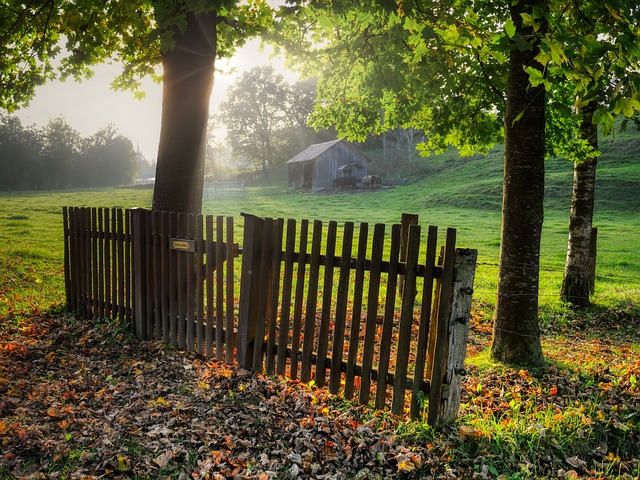Large properties present unique fencing challenges, demanding durable, expansive solutions without breaking the bank. This article guides homeowners and land managers through a comprehensive approach to cost-effective fencing, addressing diverse needs from security to privacy. We explore the pros and cons of traditional fencing versus innovative alternatives, offering natural barriers like hedgerows and fences made from sustainable materials. Additionally, we delve into DIY options for installation and maintenance tips to ensure long-term savings.
- Understanding Fencing Needs for Large Properties
- Traditional Fencing vs. Cost-Effective Alternatives
- Natural Barriers: Using Elements to Your Advantage
- DIY Options for Saving on Installation Costs
- Long-Term Savings and Maintenance Tips
Understanding Fencing Needs for Large Properties
Fencing large properties presents unique challenges compared to smaller plots. Property owners need to consider both aesthetic and functional aspects, ensuring the fence complements the landscape while providing security and privacy. The size and layout of the property play a significant role in determining suitable fencing solutions; for instance, perimeter fences for expansive rural lands may require durable materials like steel or concrete to withstand potential damage from wildlife or extreme weather conditions.
Additionally, large properties often have diverse terrain, which calls for flexible fencing options that can adapt to hills, valleys, and other natural features. There’s also the practical consideration of installation complexity and cost. Efficient fencing solutions for large properties should aim to balance these factors, offering both durability and an aesthetically pleasing design without breaking the bank.
Traditional Fencing vs. Cost-Effective Alternatives
Traditional fencing methods can be expensive and often require regular maintenance, making them less appealing for large properties. The cost of materials, labor, and ongoing upkeep can add up significantly over time. However, there are cost-effective alternatives that offer both functionality and aesthetics without breaking the bank. These innovative solutions provide a more affordable path to securing and enhancing large spaces, ensuring privacy and safety while being kind to your wallet.
Compared to conventional fences, modern options often utilize sustainable materials, advanced technologies, or creative designs to reduce costs. For instance, vinyl fencing is a popular alternative known for its durability, low-maintenance nature, and wide range of styles. This material is also budget-friendly and requires minimal upkeep, making it ideal for large properties seeking a long-lasting yet cost-efficient barrier. Additionally, pre-assembled fence panels offer another cost-saving method, streamlining installation and reducing labor expenses.
Natural Barriers: Using Elements to Your Advantage
Large properties offer unique challenges when it comes to fencing, but natural barriers can provide an aesthetically pleasing and cost-effective solution. Instead of traditional fences, consider utilizing elements found in your landscape to create a secure perimeter. For instance, planting dense hedges or trees along the desired boundary can serve as a natural fence, saving on installation costs and maintenance. These organic barriers not only offer privacy but also attract local wildlife, enhancing the overall ecosystem of your property.
Additionally, water features like streams or ponds can double as effective boundaries. Building a custom-designed dry creek bed or installing a small waterfall along the property line creates an elegant and cost-efficient division. Such natural elements not only add visual appeal but also provide a unique way to define spaces, allowing you to create diverse zones within your large property while keeping costs low.
DIY Options for Saving on Installation Costs
For those looking to keep costs down, exploring DIY fencing options can be a smart move. Installing a fence yourself is a significant way to save on labour expenses, which can account for a substantial portion of overall installation costs. With careful planning and some basic tools and materials, homeowners can successfully erect various types of fences, from wooden posts to chain link barriers. Online tutorials and how-to guides are readily available, making it accessible for even first-time DIY enthusiasts.
Many hardware stores offer affordable fencing kits that include all the necessary components and clear instructions, simplifying the process further. While there might be challenges, particularly with complex designs or longer runs, the potential savings can make DIY fencing a rewarding endeavor. Plus, taking on the project yourself allows for customization to fit specific property needs and aesthetic preferences without the premium associated with professional installation services.
Long-Term Savings and Maintenance Tips
When considering fencing for large properties, long-term savings should be at the forefront of your mind. Durable materials like high-density polyethylene (HDPE) or steel can withstand harsh weather conditions and reduce the need for frequent repairs or replacements. Investing in quality fences not only saves on immediate installation costs but also minimizes future expenses. Regular cleaning, inspection, and minor maintenance checks can help extend the life of your fence, ensuring it remains functional and aesthetically pleasing.
Maintenance tips include keeping an eye out for loose or damaged panels, securing gates properly to prevent sagging, and trimming trees or shrubs that might interfere with the fence’s integrity. Consider using water-based stains or sealers to protect wooden fences from rot and insect damage. With proper care, your fencing solution can serve as a reliable boundary for many years, providing both security and enhanced property value.
